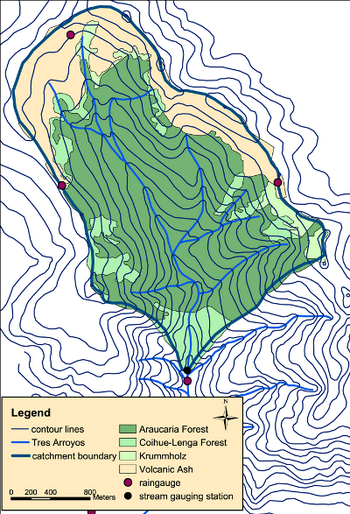Malalcahuello Catchment
The Malalcahuello Catchment is sometimes also called the catchment of the Tres Arroyos.
Location
On the southern slope of the volcano Lonquimay, IXth Region, Southern Chile
Catchment size
ca. 6 km²
Climate
humid-temperate with altitudinal effects, snow in higher altitudes during winter
Geology
volcanic ashes, andesite
Topography
steep slopes, elevations range from 1120 m to 1856 m above sea level
Vegetation/Land use
old growth forest, no anthropogenic intervention
Context of investigation
several studies have been carried out in this catchment. Research topics include:
- Runoff generation processes
- Sediment transport
- Debris flow
- Large woody debris
- Interception
Measurements/Equipment
- water level
- rainfall
- groundwater levels
- soil moisture
- interception
- tracer experiments
- bedload transport
- ...
Links to project webpages
References
- Blume T., Zehe E., Bronstert A. (2007): Rainfall runoff response, event-based runoff coefficients and hydrograph separation. Hydrological Sciences Journal. 52: 843-862.
- Blume T., Zehe E., Bronstert A. ((2009): Use of soil moisture dynamics and patterns at different spatio-temporal scales for the investigation of subsurface flow processes. Hydrology and Earth System Sciences, 13(7), 1215-1233.
- Blume T., Zehe E., Reusser D.E., Iroumé A., Bronstert A. (2008): Investigation of runoff generation in a pristine, poorly gauged catchment in the Chilean Andes. I: A multi-method experimental study. Hydrological Processes, 22(18), 3661-3675, DOI: 10.1002/hyp.6971.
- Blume T., Zehe E., Bronstert, A. (2008): Investigation of runoff generation in a pristine, poorly gauged catchment in the Chilean Andes. II: Qualitative and quantitative use of tracers at three spatial scales. Hydrological Processes, 22(18), 3676-3688, DOI: 10.1002/hyp.6970.
- Blume T., Zehe E., Bronstert A. ((2008): Field observations of persistent preferential flowpaths in volcanic ash soils as a result of hydrophobicity. ysopp poster 2008 EGU.
- Blume T., Zehe E., Bronstert A. ((2009): Use of soil moisture dynamics and patterns at different spatio-temporal scales for the investigation of subsurface flow processes. Hydrology and Earth System Sciences, 13(7), 1215-1233.
- Blume, T. (2008): Hydrological processes in volcanic ash soils - Measuring, modelling and understanding runoff generation in an undisturbed catchment, Dissertation, University of Potsdam, Germany.
- Zehe, E., Blume, T., Blöschel, G. (2010): The principle of 'maximum energy dissipation': a novel thermodynamic perspective on rapid water flow in connected soil structures. PHILOSOPHICAL TRANSACTIONS OF THE ROYAL SOCIETY B-BIOLOGICAL SCIENCES, 365(1545), 1377-1386, DOI: 10.1098/rstb.2009.0308.
- Zehe, E., Blume, T., Kleidon, A., Ehret, U., Scherer, U., Westhoff, M.(2012): Connected flow paths as first order control on critical zone water flows: coincidence or self-organized optimality? Hydrol. Earth Syst. Sci. Discuss., 9, 10595-10655, DOI: 10.5194/hessd-9-10595-2012.
